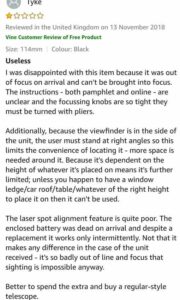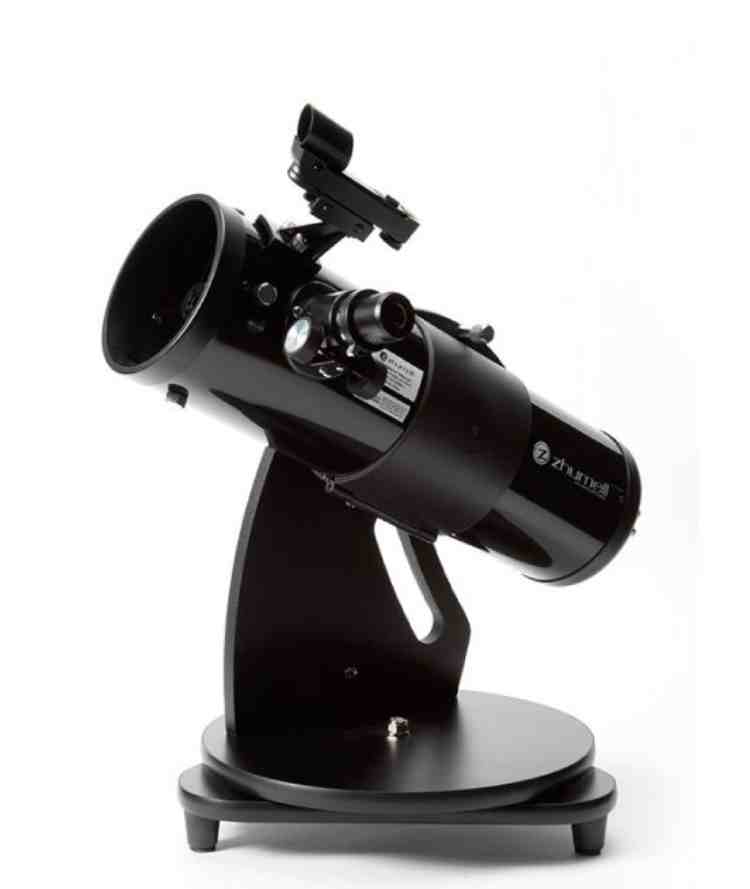*This post may contain affiliate links. This means we may make a commission if you purchase an item using one of our links*
If you’re on this Zhumell Z114 review, you’re probably in the market for a portable yet fairly compotent device and the Zhumell Z114 has been recommended as being such a telescope right?
If so, you’ve come to the right place. In this review I’ll be covering the pros, cons, features and other important elements to help you out to ultimately make a decision on whether the Zhumell Z114 is device worth buying or one you should skip.
Overview
Table of Contents
- Full Name: Zhumell Z114
- Type: Newtonian Reflector
- Aperture: 5″(114mm)
- Focal length: 465mm
- Focal ratio: f/4.07
- Dimensions & Weight: 47 x 34.3 x 41.3 cm by 4.47 kg
- Included eyepieces: 17mm and 10mm 1.25″
- Rating: 4/5
Pros
- Good accessories in the box
- Good specifications for the price
- Very portable
- Great for young kids due to its easy to use optics
Cons
- The viewfinder is awkwardly positioned on the side
- Will require regular maintenance due to exposed optics
- Collimation process can be a bit finicky
- Industry standard 1.25” focuser, compatible with many different accessories
- Changing magnifications is easier than ever with included 17mm and 10mm eyepieces
- Easy to use red dot finder makes aiming the Z114 a breeze for any level of user
How Do The Zhumell Z114’s Optics Work?
If you don’t already know, telescopes tend to come in 3 different variations of optics, in the reflector, refractor and compound/Catadioptric designs, with further sub categories within each variation.
All of them have their pros and cons and will set you back different amounts of money due to how much they cost to manufacture etc.
In the case of the Zhumell Z114, it’s a reflector based system, which in the form of the very popular and common Newtonian reflector design. The pros of the reflector optics means that telescopes that use them do cost a bit less than refractor and compound telescopes with the same power whilst also being better at viewing faint objects in outer space.
These devices also don’t suffer from the common issue of chromatic aberration that cheaper refractor devices tend to have and are able to basically observe all kinds of light, unlike refractor’s which can’t observe ultraviolet light due to their thicker lenses.
However, there are a few annoyances with reflector based optics too. As the optics are exposed, you will need to maintain it regularly and you’ll also need to collimate (re-align) the mirrors pretty much every time you decide to use a reflector device.
Of course as the Zhumell 114 is a very beginner level scope, considering it’s pricetag of less than $150, you’d probably need to deal with this issue a lot more. In fact some users have found this to be too detrimental a problem, which is made even more annoying due to the Zhumell Z114 having tight knobs on the side, making it a hard to realign the optics without bringing out the pliers.
Anyways, these are the basic characteristics of the optics found within The Z114. As for how well the specifications translate to real world use, I’ll cover it in the next section
What Do The Zhumell Z114’s Specifications Mean?
The Zhumell Z114 has an aperture of 114mm, a focal length of 465mm resulting in a very fast and wide focal ratio of f/4.07.
This means that the Z114 will be able to magnify, with the use of the correct eyepieces, to a pretty reasonable theoretical magnification of 224x although the useful magnification will more than likely be lower at around 200x instead.
The small focal ratio also means that the image you’ll see through the telescopes viewfinder will be very wide so, you’ll be able to see a lot more of outer space at once. The downside is that the views of planets won’t be as detailed because narrower focal ratios of f/8+ are better for planetary viewing.
The other downside to the larger focal ratio is that coma (elongated stars that basically look a comet instead of circular bright orbs) will be more visible for stars at the edges of the image but, this shouldn’t detract too much from the experience nearer the centre of the viewfinder.
As for what you’ll be able to see with the scope, the moon will look really good and viewing the craters on the surface of the lunar object will look pretty darn detailed as well at the the upper end of the magnification possible by the Z114.
You’ll be able to make out Jupiter in solid detail and you may just be able to observe separation in Saturn’s rings.
Of course the device will allow you to make out multiple star clusters, galaxies, nebulaes and so on, provided you’re observing in the ideal conditions.
In short it should do a competent job as a beginner level system but, for the most detailed and overall higher quality views, you’d need to be willing to spend a lot more than on the Z114. If your budget can stretch a little more, giving the bigger brother in the Zhumell Z130 will probably be a good option.
In regards to its portability, the Z114 shouldn’t disappoint you there whatsoever. With the dimensions and weight being 47 x 34.3 x 41.3 cm by 4.47 kg, moving the system around should honestly be a breeze and with the tabletop designed mount that it uses, it’ll also be easy to store although, the design of the mount may not make it the easiest of things to observe through in very compact areas.
Overall the specs and portability for the price aren’t something I can knock the Zhumell Z114 for.
Accessories Included In The Box?
The accessories in the box include a 1.25” focuser, two 1.25″ 17mm and 10mm eyepieces, a Red Dot Finder and a fair few other manuals and miscellaneous paperwork.
The 2 eyepieces seem to be pretty decent quality for the price and will get the job done for a beginner, of course it will be worth upgrading a little down the road but as an in the box accessory, the eyepieces are decent.
==>Click Here To Check Zhumell Z114’s Pricing On Amazon!
The Mount
As for the mount, it’s a tabletop Dobsonian style mount which is fairly easy to set up although it does have a few awkward problems.
This includes the knobs being a little tough to turn to deal with the collimation and the viewfinder being placed on the side of the scope, making it a little awkward to position your face in order to view space but, as a whole the mount is sturdy and is a decent if you’re looking for a smaller footprint telescope.
What Are Users Of The Zhumell Z114 Saying?
I found that most users of the device have said that the Z114 is a solid beginner level device that gets a lot of thing right, if you’re unable to spend too much.


The biggest complaint that I could find about the device was regarding its mediocre battery life, the annoying prospect of collimating the mirrors and the laser spot alignment feature being poor for one particular customer.

However, the majority of users did find this to be a great starter astronomy telescope for younger children or even curious astronomers so, from what I’ve gathered, it does seem as if the Z114 is a pretty solid 5 inch device.
Other Alternatives Worth Checking Out
If you’re willing to stretch the budget a little, you can check out this list I created on the best telescope I know of in the $300 range.
If your looking for other reasonably portable devices but really want a more powerful device, you can also check out this best of list I created on telescope that fall within that area.
Summary
The Zhumell Z114 is a solid beginner level 5 inch system, having some decent accessories in the box, good build quality, great optics for the price and of course the great portability it provides.
Nevertheless, it does have a few problems of its own, such as a few awkward design elements with the mount and the inherent problems most reflector devices show, such as the collimation and maintenance aspect of the device.
If you’re only looking for a 5inch device, the Z114 is definitely a solid pick in this market but, I’d personally recommend spending a little more to purchase the Z130 as it’s also decently portable whilst providing a better experience overall.
Nevertheless, the Zhumell Z114 is solid offering within this price bracket, especially if you’re not willing to invest a bit more for a more powerful device.


